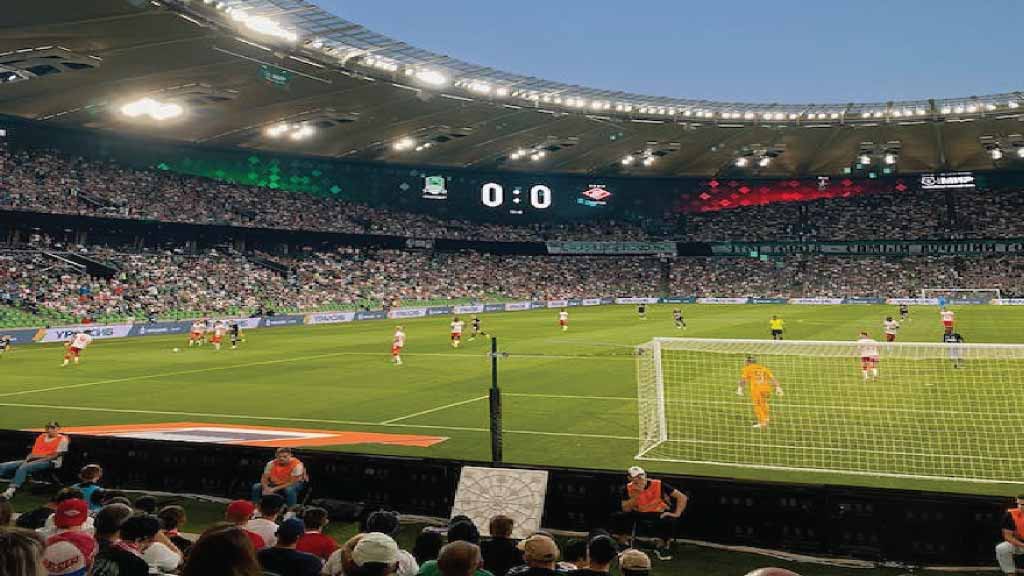Soccer, or football, as it’s known in many parts of the world, boasts an immense following, captivating millions with its electrifying matches. At the heart of its allure lies the sport’s dynamic and fluid gameplay, drawing in players and spectators alike. Yet, to fully appreciate the game, it’s crucial to grasp the intricacies of its duration. Understanding the structure of a soccer game is fundamental for participants and fans alike. This exploration will delve into the standard duration of a game, the concept of additional time, and the variations encountered across different levels of play.
By unraveling these elements, we can deepen our appreciation for the beautiful game and gain insights into its rich tapestry of competition and strategy.
Table of Contents
ToggleStandard Duration of a Soccer Game:
In the realm of soccer, the standard duration of a game is a well established framework, characterized by two intense halves, each spanning a robust 45 minutes. This structure ensures a captivating display of skill, strategy, and athleticism, embraced across the globe in prestigious competitions like the FIFA World Cup and revered domestic leagues such as the English Premier League and La Liga. Within these halves, the action unfolds in distinct phases: the initial 45 minutes followed by a halftime interval for teams to regroup, recharge, and recalibrate their strategies.
This standardized format not only provides a balanced platform for teams to showcase their prowess but also sets the stage for thrilling moments of triumph and tension. Whether it’s a tightly contested battle or a display of dominance, the 90-minute standard duration encapsulates the essence of soccer, captivating fans with its blend of drama, skill, and sheer determination.
Halftime Interval:
The halftime interval in soccer serves as a pivotal juncture within the game, offering players a crucial opportunity to regroup and recharge. Lasting typically for 15 minutes, this interlude allows athletes to replenish their energy reserves through hydration and brief rest. Equally important is the chance for coaches to impart strategic insights, fine tune tactics, and address any shortcomings observed in the opening half. It’s a time for reflection and adjustment, where teams can recalibrate their approach to better meet the challenges posed by their opponents. Additionally, the halftime break facilitates player substitutions, enabling teams to inject fresh legs or tactical variations into their lineup.
This brief respite amid the intensity of play serves not only as a physical reprieve but also as a mental reset, instilling renewed focus and determination for the remainder of the match. Ultimately, the halftime interval plays a vital role in shaping the trajectory of a soccer game, often serving as a turning point where fortunes can be reversed or consolidated.
Additional Time:
In the dynamic world of soccer, the concept of additional time adds an intriguing layer of suspense and opportunity to the game. When the clock nears the end of each half, the referee holds the authority to extend play beyond the standard 45 minutes, compensating for interruptions that occurred during regulation time. These interruptions, which can range from injuries requiring medical attention to tactical delays aimed at disrupting the flow of the game, are carefully noted by the officiating team.
The announcement of additional time, often signaled by the fourth official holding up a board displaying the indicated minutes, injects a surge of adrenaline into players and spectators alike. Known by various monikers such as “injury time” or “stoppage time,” this extension can vary in duration, typically spanning anywhere from one to five minutes per half. However, in rare instances where significant delays have occurred, the referee may choose to allocate even more time to ensure fairness and completion of the match.
This period of additional time becomes a crucial battleground where teams strive to capitalize on every second, either to protect their lead or stage a dramatic comeback. Thus, the inclusion of extra time not only adds suspense but also emphasizes the unpredictable nature of soccer, keeping fans on the edge of their seats until the final whistle blows.
Factors Influencing Game Duration:
The duration of a soccer game can be influenced by various factors, each playing a role in shaping the overall experience on the field. At the professional level, where precision and adherence to regulations are paramount, games typically adhere closely to the standard 90-minute format. Stringent timekeeping measures ensure that matches in prestigious leagues and international competitions progress with a predictable rhythm, consisting of two halves, each lasting 45 minutes, with a 15-minute halftime interval.
In contrast, the landscape of amateur or youth soccer presents a more flexible approach to game durations. Here, the focus often extends beyond competition to encompass player development and logistical considerations. As a result, matches at these levels may vary in length, with organizers opting for shorter game times to accommodate younger players’ attention spans and physical endurance. Additionally, logistical constraints such as field availability and scheduling demands can also impact game durations, leading to adjustments in playing time to accommodate multiple matches or events within a limited timeframe.
Overall, while professional soccer adheres rigorously to standardized game durations, the amateur and youth levels offer a more adaptable approach, tailored to prioritize player development and logistical efficiency. This variability underscores the diverse nature of the sport, accommodating different needs and objectives across various levels of play.
Variations in Game Duration:
Variations in the duration of soccer games reflect the adaptability of the sport to different contexts and objectives. While the standard duration of 90 minutes is a hallmark of professional soccer, adjustments are often made to suit specific needs, particularly in youth leagues where player development takes precedence. In these settings, shorter game times are frequently employed to cater to the age and skill level of participants, ensuring that matches remain engaging and manageable for young athletes.
Moreover, the landscape of knockout tournaments and cup competitions introduces further variations in game duration. In events such as the FA Cup or Copa del Rey, where the stakes are high and every moment counts, matches may extend beyond regulation time if the score remains level. This additional period, known as extra time, offers teams an opportunity to break the deadlock and secure victory through continued play. Should the tie persist even after extra time, the tension reaches its peak with the possibility of a penalty shootout, a dramatic spectacle where nerves are tested and heroes emerge.
These variations in game duration underscore the dynamic nature of soccer, accommodating diverse settings and competitive formats while maintaining the essence of the sport’s excitement and unpredictability. Whether it’s adapting to the needs of young players or navigating the high pressure environment of cup competitions, soccer continues to captivate audiences worldwide with its ability to evolve and thrill across different contexts.
Conclusion About How Long is a Soccer Game:
Understanding the duration of a soccer game is fundamental for players, coaches, officials, and fans alike. With its standard format of two 45-minute halves, separated by a halftime interval, a typical soccer match offers 90 minutes of intense action. However, the inclusion of additional time to compensate for stoppages ensures that the game’s outcome is determined fairly. While variations in game duration may exist across different levels of play and competition formats, the essence of soccer remains unchanged, a thrilling spectacle enjoyed by millions around the world.
FAQs:
How long does a soccer game last?
A standard soccer game typically lasts for 90 minutes, divided into two halves of 45 minutes each, with a halftime break in between. However, the actual duration can vary due to additional time added by the referee to compensate for stoppages during play.
Why is soccer played in two halves?
Soccer is played in two halves to ensure fairness and provide teams with an opportunity to regroup and strategize during halftime. This format also adds to the excitement and intensity of the game, allowing for momentum shifts and strategic adjustments.
How long is halftime in soccer?
Halftime in soccer typically lasts for 15 minutes. During this time, players have a chance to rest, hydrate, and receive tactical instructions from their coaches. It serves as a crucial interval to recharge both physically and mentally before resuming play in the second half.
What is stoppage time in soccer?
Stoppage time, also known as injury or added time, refers to the minutes added by the referee at the end of each half to compensate for delays during regular play. These delays can include injuries, substitutions, and other interruptions that occurred but were not accounted for in the standard 90 minutes.
Do soccer games always last for 90 minutes?
While the standard duration of a soccer game is 90 minutes, including stoppage time, variations can occur. In certain circumstances, such as knockout tournaments or cup competitions, matches may extend beyond 90 minutes into extra time or even a penalty shootout to determine a winner.

